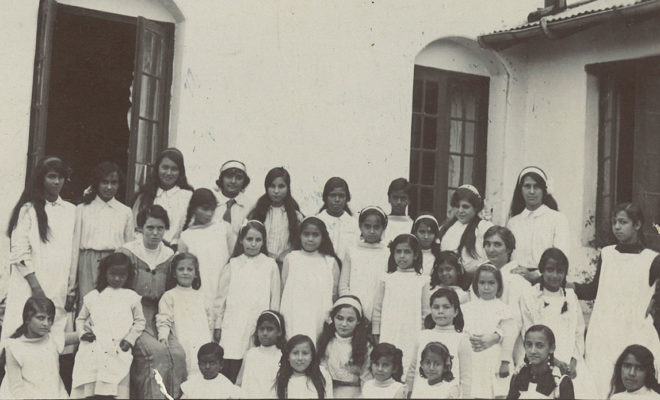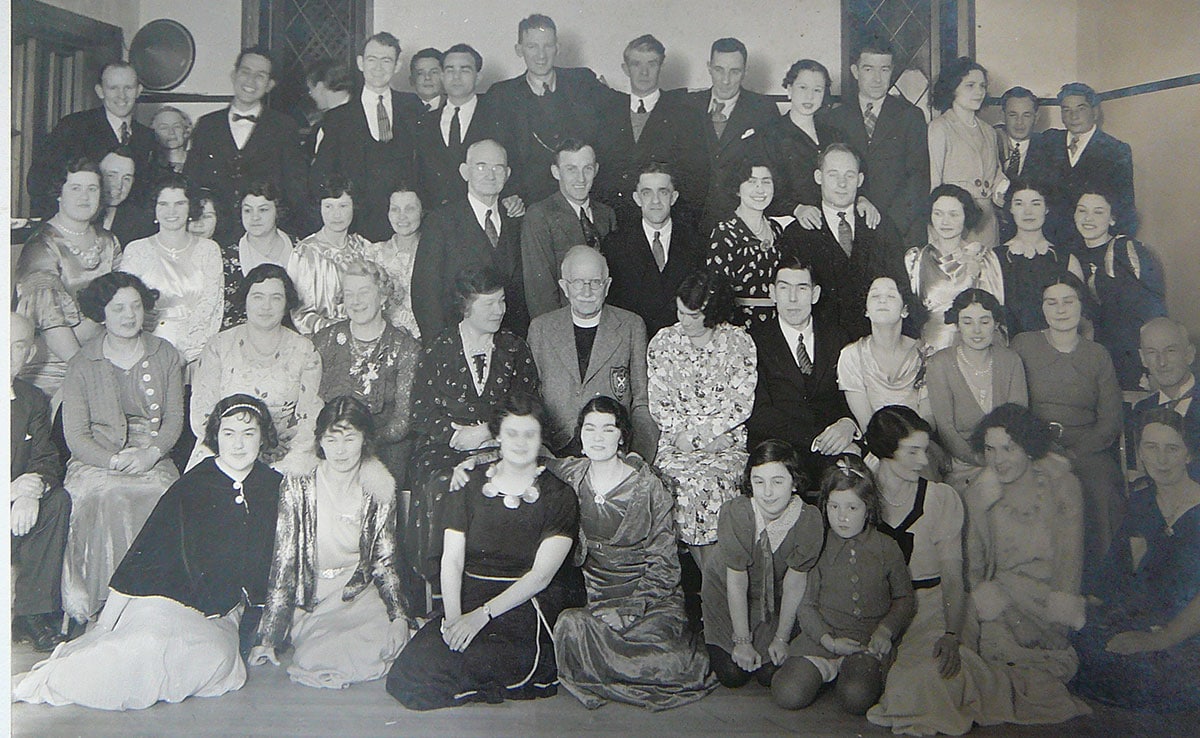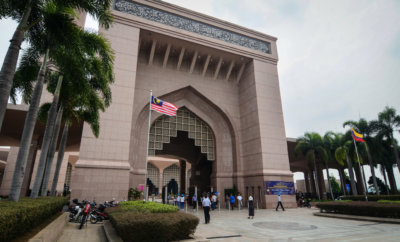Life
Kalimpong Kids: Search for Indian Identity in New Zealand

Woodburn Cottage group, Kalimpong, approx 1916. Jane McCabe’s grandmother, Lorna Peters, standing far right, with hand on hip.
A new book retraces the suppressed story of 130 mixed-race children sent from West Bengal to New Zealand a century ago.
As tumultuous as the thousands of miles of seas that separate Bengal and New Zealand is the story of the Kalimpong kids. Of their lost childhoods, shaken identities and faded memories. Of questions that lingered in the young minds a century ago. Of answers that their descendants continue to seek today.
The Kalimpong kids — nearly 130 of them — reached the island country in batches between 1908 and 1938. They were all residents of Dr Graham’s Homes, run by a Scottish Presbyterian missionary in the tiny Himalayan hamlet of Kalimpong, who were sent half-way around the world to find new lives. The familiar sight of the steadfast lofty mountains was no longer there to comfort them. It was replaced by roars of the raging ocean, an apt symbol perhaps of the way life changed for the children, then aged between 10 and 15 years.
Life has also not been the same for Dr Jane McCabe, the author of the recent monograph Race, Tea and Colonial Resettlement, since she chanced upon an old photograph of her grandmother Lorna Peters at her house in New Zealand in 2007. The photograph was captioned “Kalimpong school.” Until then, McCabe was unaware of the connection her life held with Kalimpong, or with India. And that hers was not the only family that was part of the planned exodus that took place two generations ago.
“I only became aware that she was part of a larger scheme when I visited Kalimpong and noticed many photographs of New Zealanders in the school magazine,” McCabe, a lecturer in history at the University of Otago in New Zealand, tells Little India.
Thus began her fervent research into the history of the Anglo-Indian community, leading her to pursue a Ph.D. on Kalimpong emigrants in New Zealand. McCabe, who recently organized a reunion of their descendants at Upper Hutt, has been absorbed in the story for six years, during which she has made trips to the West Bengal town, traveled around New Zealand to make contacts with children of the emigrants, and collected old photographs and stories to piece together the remnants strewn over the two countries.
The little migrants, she says, were mixed-race children of British tea planters and Indian or Nepalese women from the region who were taken into Dr Graham’s Homes. Because they were born out of relationships that did not have social sanction during the era — English planters could not marry until they became managers, a process that took as long as 10 years — meant the children were not accepted into either culture. The institution, opened in 1900 by Dr John Anderson Graham, provided home and European education to them, before they were sent to the colonies to work as young adults.
In New Zealand, boys were engaged to work on farms, while girls were placed as domestic helps.
The children never returned to the home of their birth. They did not see their mothers again. A few, however, reunited with their fathers when the tea planters chose to visit them in their twilight years.
McCabe’s grandmother, who arrived in Dunedin with five others from Dr Graham’s Homes in 1921, died in 1978, without ever speaking about her Indian roots.
“For our family, it was mostly a sense of relief and interest in knowing anything about her background, as previously we thought of it as completely mysterious and unknowable,” says McCabe. Even though her grandmother was eventually joined by her tea planter father in New Zealand, she never spoke about Kalimpong or kept in touch with other emigrants. And she wasn’t the only one who kept the past so well hidden, McCabe discovered during her interactions with other descendants.
“If there is a general sentiment among descendants, it is one of sadness that the Kalimpong emigrants felt unable to discuss their past, even with their own children and grandchildren,” McCabe says, pointing out that there may have been a protective element to this silence, as many descendants enjoyed good relationships with their parents and grandparents in Kalimpong.
“The stigma of the period around race mixing, illegitimacy and institutionalization perhaps made them feel that they would be burdening their children if they passed any details of their upbringing on,” she adds. “We also assume that there was considerable trauma and confusion about being separated from their parents and sent away from the plantation at a young age, usually permanently.”

1937 reunion of graduates with John Graham (center) at the Didsbury residence in Wellington, New Zealand.
Though Dr Graham hoped the emigrants would, in the course of time, move from being farm hands to farm owners in New Zealand, the prevailing social conditions of the early 20th century did not favor the transition. Most men in subsequent years took up white collar work, while others set up small businesses or entered professions. Several of them volunteered for service in World War I and World War II, and many were killed in action, or wounded or otherwise affected by the experience of war.
The women mostly found their place through marriage. “Apart from work, many have been quite involved in their local communities, as is often the way with new migrants,” says McCabe. “Others, like my grandmother, remained on the outskirts of society, but nevertheless were content with their place in the world.” Most members of the community remained very committed to their own families, she says, perhaps as a result of their early separations.

Jane McCabe: “The stigma of the period around race mixing, illegitimacy and institutionalization perhaps made them feel that they would be burdening their children if they passed any details of their upbringing on.”
McCabe, who found during her research that the original emigrants had all passed away, except for two members of the final 1938 group who are in their late 90s, interacted closely with the descendants in New Zealand to collect information for the project. Though she encountered a range of emotional responses from the emigrants, the one common thread was the sense of unease they felt about their origins.
“But this is mostly because they simply have not known what their origins were,” she says. “The more we learn about the heritage, and speak to each other about our experiences, the more settled we feel.”
There is also a lingering resentment at the erasure of their Indian mothers from the written record. So the descendants have no way of following up on this side of their history, says McCabe.
The lacuna that they felt in their lives continues to burden them to this day. The new generation is keen to pick up the lost shards of their lineage. While the Kalimpong emigrants mostly concealed their Indian origins, often saying things like “I’m British and that’s all there is to it,” in response to questions about their ancestry, there has been a complete turn-around among the next generation. “Most descendants feel a sense of loss that they have no specific knowledge of their Indian ancestry,” says McCabe. “Many have travelled to Kalimpong and other parts of India to try to reconnect.”
McCabe is now working on a second book, due to be published by Otago University Press in 2018, that will relate more stories of the Kalimpong emigrants’ lives in New Zealand, and those in the local community who were a part of Graham’s network, including employers, supporters and committee people. The book will be in the form of an album, comprising some of the images that she came across in family collections. Images that are certain to speak thousands of words about little lives changed over thousands of miles of seas.



